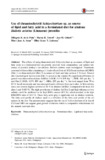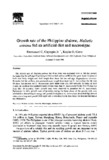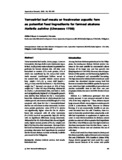| dc.contributor.author | Lebata-Ramos, Ma. Junemie Hazel | |
| dc.contributor.author | Solis, Ellen Flor D. | |
| dc.date.accessioned | 2021-02-05T05:25:08Z | |
| dc.date.available | 2021-02-05T05:25:08Z | |
| dc.date.issued | 2021-02-04 | |
| dc.identifier.citation | Lebata-Ramos, M. J. H., & Solis, E. F. D. (2021). Can Ulva reticulata replace Gracilariopsis heteroclada as natural food for the abalone Haliotis asinina? Journal of Applied Phycology, 33(3), 1869-1872. | en |
| dc.identifier.issn | 0921-8971 | |
| dc.identifier.uri | http://hdl.handle.net/10862/6030 | |
| dc.description.abstract | Abalone are among the most important fishery resources with high commercial values worldwide, with Haliotis asinina being the most in demand and widely studied species in the Philippines. Abalone culture in the country mainly depends on the red alga, Gracilariopsis heteroclada, as food for cultured stocks. This however, is not sustainable as this alga is also being farmed both for agar production and human consumption. Hence, other sources of natural food need to be explored for large-scale culture of abalone. This study investigated the viability of Ulva reticulata as food for abalone. This green alga is common in the intertidal zones of the Philippines but of no commercial value. H. asinina early juveniles (N = 60, shell length 2.12–3.07 cm, body weight 1.7–5.9 g) obtained from the Abalone Hatchery of SEAFDEC Aquaculture Department were randomly distributed (n = 10) in three replicate containers and fed with G. heteroclada and U. reticulata for 15 days. After 15 days, abalone fed with G. heteroclada were significantly larger and heavier (2.82 ± 0.04 cm and 4.64 ± 0.19 g) than those fed with U. reticulata (2.62 ± 0.03 cm and 3.45 ± 0.14 g). Abalone fed with U. reticulata also exhibited weakness, hardfoot, and easily detached from the walls of the culture containers. Based on these results, despite its availability in large quantities, U. reticulata could not be solely used as an alternative natural food to G. heteroclada for abalone culture. However, its potential as a partial substitute to G. heteroclada may be further examined. | en |
| dc.description.sponsorship | The authors greatly appreciate the Abalone Hatchery Team for providing the abalone juveniles used in the study; the management of Ayala Corporation and Ayala Land, Inc. for the project collaboration (Budget Code: 6287-T-RD-AYALA2); SEAFDEC Aquaculture Department for partly funding the study (Study Code: TV-04-M2018T); Drs. Anicia Hurtado and Iris Ann Borlongan for identifying the seaweed samples; and the anonymous journal reviewers for painstakingly reviewing the manuscript. | en |
| dc.language.iso | en | en |
| dc.publisher | Springer | en |
| dc.subject | abalones | en |
| dc.subject | Ulva reticulata | en |
| dc.subject | Haliotis asinina | en |
| dc.subject.lcsh | SEAFDEC/AQD | en |
| dc.title | Can Ulva reticulata replace Gracilariopsis heteroclada as natural food for the abalone Haliotis asinina? | en |
| dc.type | Article | en |
| dc.citation.volume | 33 | |
| dc.citation.issue | 3 | |
| dc.citation.spage | 1869 | |
| dc.citation.epage | 1872 | |
| dc.citation.journalTitle | Journal of Applied Phycology | en |
| dc.subject.asfa | feeds | en |
| dc.subject.asfa | abalone culture | en |
| dc.subject.asfa | feeding experiments | en |
| dc.subject.asfa | feeding | en |
| dc.subject.asfa | feed conversion efficiency | en |
| dc.subject.asfa | diet | en |
| dc.subject.asfa | seaweeds | en |
| dc.identifier.essn | 1573-5176 | |
| dc.identifier.doi | 10.1007/s10811-021-02407-1 | |
| dc.subject.scientificName | Gracilariopsis heteroclada | |
| dc.subject.scientificName | Ulva reticulata | |
| dc.subject.scientificName | Haliotis asinina | en |
| local.subject | Haliotis asinina | en |
| local.subject | Feed | en |
| local.subject | Gracilariopsis heteroclada | en |
| local.subject | Ulva reticulata | en |
| local.subject | SEAFDEC/AQD | en |



